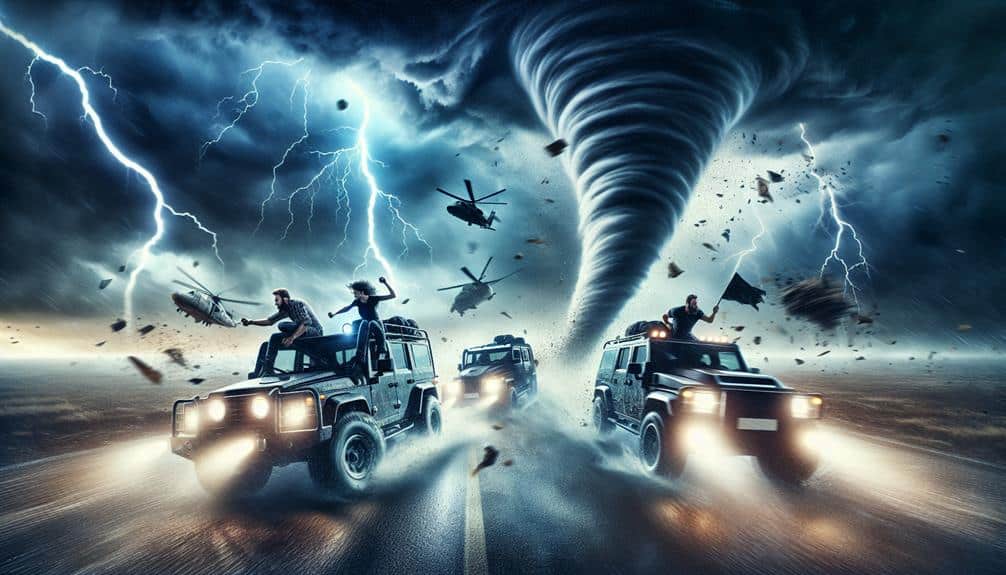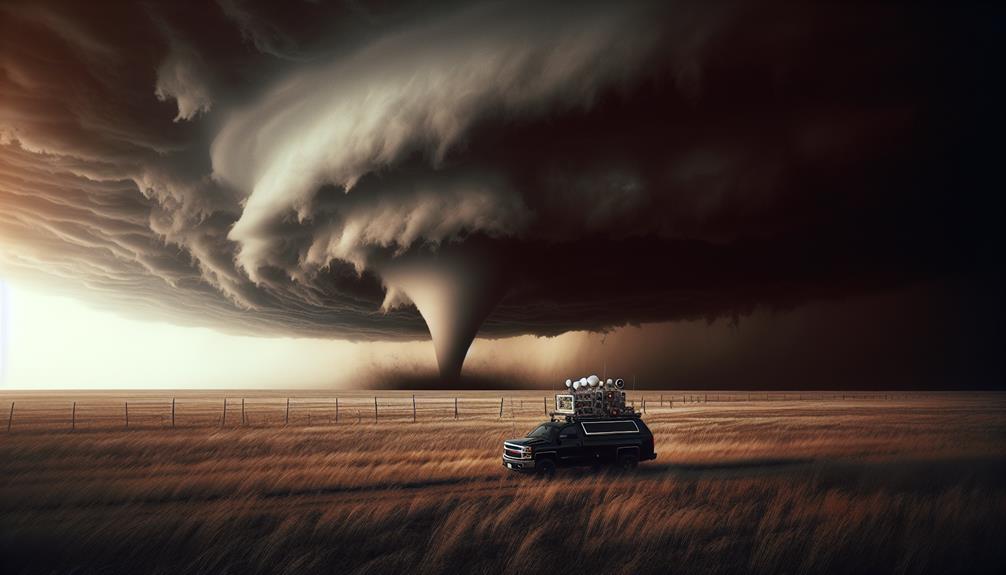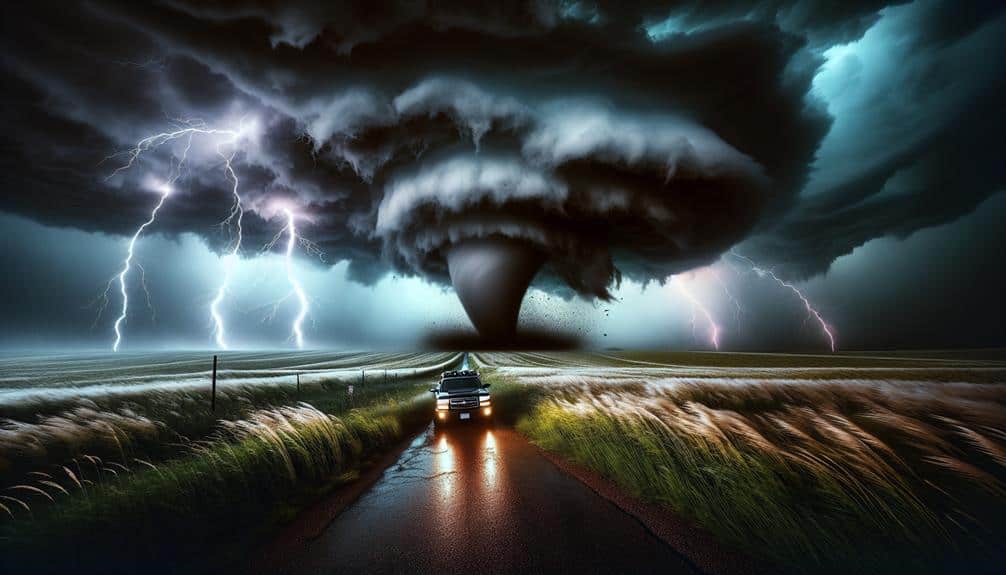We plunge headfirst into storm chasing, fueled by analyzing meteorological data and intercepting severe weather phenomena. Tracking atmospheric conditions like wind shear, dew points, and Convective Available Potential Energy (CAPE) guides our high-speed pursuits. Utilizing Doppler radar and satellite imaging enhances our prediction accuracy. The thrill intensifies as we witness mesocyclones or deploy real-time data capture tools near towering supercells. Balancing the perilous maneuvers required to stay close to storms with meticulous radar analysis guarantees both safety and excitement. Embracing cutting-edge technology while fostering community camaraderie, we push the boundaries of weather science. Let's explore further for deeper insights.
Key Points
- Intercepting severe weather phenomena provides a thrilling, real-time challenge for storm chasers.
- High-speed pursuits require daring maneuvers to stay close to unpredictable storms.
- Close encounters with tornadoes and extreme weather offer heart-stopping visual spectacles.
- Mastering advanced technology like Doppler radar enhances the excitement of tracking and predicting storms.
The Thrill of the Hunt
The thrill of the hunt in storm chasing stems from the precise analysis of meteorological data and the anticipation of intercepting severe weather phenomena. We meticulously track atmospheric conditions, scrutinize radar imagery, and interpret weather models. Our eyes are glued to parameters like wind shear, dew points, and CAPE (Convective Available Potential Energy). These indicators guide us to the genesis of supercells and tornadoes, promising the intense excitement we crave.
We harness cutting-edge technology to predict the unpredictable. Doppler radar scans reveal the velocity and structure of storm systems, while satellite data provides a broader view of developing weather patterns. As we narrow down the target area, the rush of danger becomes palpable. Our adrenaline surges when we spot a wall cloud forming or a funnel descending from the sky.
Timing and precision are everything. We navigate rural roads, relying on GPS and real-time updates to stay one step ahead of the storm. The freedom to roam and the challenge of nature's raw power compel us forward.
Every successful intercept, every close call, fuels our passion and reminds us why storm chasing is an unparalleled pursuit of both science and adventure.
Science Behind the Storms
Understanding the science behind storms requires immersing oneself in atmospheric dynamics and thermodynamic principles. To truly grasp storm formation, we need to analyze the complex interactions between temperature, pressure, and moisture in Earth's atmosphere. By examining these variables, we can predict where and when severe weather will develop.
When we study meteorological phenomena, we look at:
- Wind shear: The change in wind speed and direction with height, vital for supercell development.
- Convective available potential energy (CAPE): Indicates the potential energy available for convection, essential for thunderstorm intensity.
Analyzing data from weather balloons, radar, and satellite imagery allows us to identify patterns in storm formation. For instance, high CAPE values combined with significant wind shear often signal the potential for severe weather, such as tornadoes and hailstorms. Understanding these patterns enables us to predict and track storms more accurately.
The freedom of storm chasing lies in our ability to navigate these meteorological phenomena, making real-time decisions based on scientific data. By mastering the science behind the storms, we not only fuel our adrenaline but also contribute valuable insights to the field of meteorology.
High-Speed Pursuits
Racing down highways in pursuit of a rapidly developing storm, we rely on cutting-edge technology and precise meteorological data to navigate the volatile conditions. Our vehicles are equipped with anemometers, barometers, and Doppler radar systems, allowing us to track wind speeds, pressure changes, and storm cell movements in real-time. This data guarantees we can maintain intense speed without compromising our safety.
Navigating through these high-speed pursuits, we often perform dangerous maneuvers to keep pace with the storm's unpredictable path. We must anticipate sudden changes in wind direction and velocity, requiring split-second decisions to avoid hazards. Our ability to analyze radar data and interpret satellite imagery provides us with a tactical advantage, allowing us to adjust our route dynamically.
Freedom on the open road is exhilarating, but it demands respect for the power of nature. We constantly assess the risk factors, balancing the thrill of the chase with the need for caution. By leveraging advanced meteorological tools and rigorous data analysis, we can experience the raw power of storms up close while minimizing our exposure to potential dangers.
This balance between intense speed and calculated risk is what makes storm chasing an unparalleled pursuit.
Close Encounters
When we experience close encounters with tornadoes, we directly witness atmospheric dynamics and wind velocities that exceed 300 miles per hour.
These observations provide critical data but also place us in life-threatening proximity to the storm's destructive core.
Our instruments must remain highly calibrated to guarantee the accuracy of measurements while prioritizing our safety.
Witnessing Nature's Power
Experiencing the full force of a tornado from a close distance provides invaluable data on wind speeds and pressure changes that are essential for advancing meteorological science. As storm chasers, we witness the raw power and jaw-dropping beauty of nature's most intense phenomena. This isn't just about the thrill; it's about collecting critical information that can save lives and improve forecasting models.
When we're out in the field, we use sophisticated instruments to capture real-time data. This includes:
- Anemometers: To measure wind speeds and turbulence.
- Barometers: To track rapid pressure changes.
These tools help us understand the dynamics of tornado genesis and progression.
The raw power of a tornado is awe-inspiring, but its complex structure and erratic behavior make it a subject of intense study. The beauty of these storms, with their twisting funnels and dramatic skies, captivates us, driving our passion for further exploration.
Life-Threatening Proximity
Our proximity to tornadoes often places us in life-threatening situations, demanding split-second decisions and a deep understanding of storm behavior to navigate safely. The risk vs reward calculus is always present; the allure of capturing extreme weather phenomena drives us, yet we must always weigh this against the potential dangers. Each chase brings an intense adrenaline rush, but it also requires strict safety precautions to mitigate the risks.
We utilize advanced meteorological tools—Doppler radar, barometric pressure sensors, and high-resolution satellite imagery—to predict storm paths and behavior accurately. Real-time data analysis is essential for making informed decisions. We must identify mesocyclones, wall clouds, and other key storm structures to estimate a tornado's trajectory and avoid its destructive core.
Despite these measures, close encounters with tornadoes remain inherently risky. Wind speeds exceeding 200 mph can turn debris into lethal projectiles, and sudden shifts in storm direction can trap us. Communication is vital; we use radios and GPS to coordinate movements and make sure no one is isolated.
While the adrenaline rush is undeniable, our survival hinges on our ability to balance the thrill of extreme weather with disciplined, data-driven decision-making.
Technological Marvels
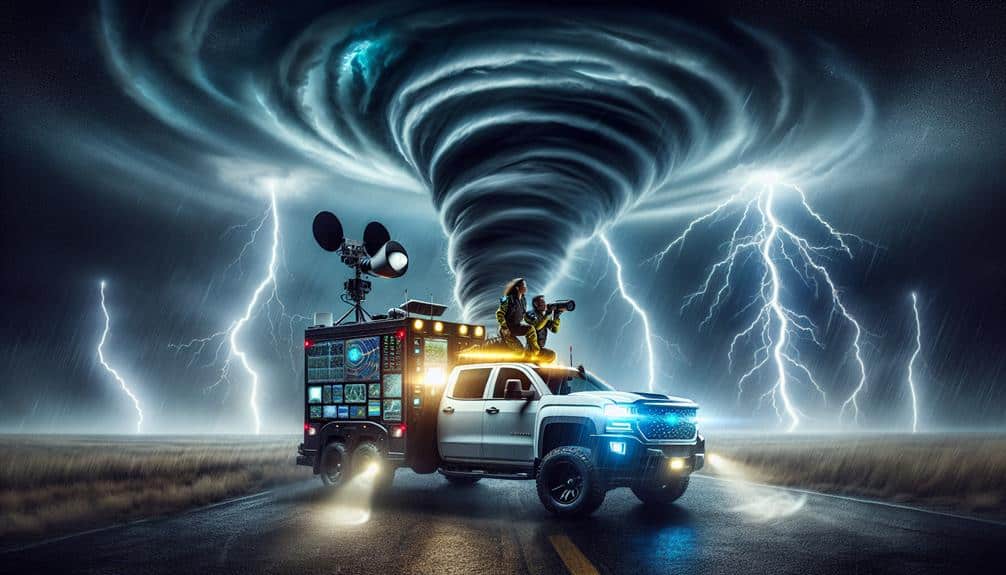
Advancements in meteorological technology, like Doppler radar and satellite imaging, have transformed our ability to predict and track severe weather phenomena. With these tools, we can anticipate storm patterns with remarkable accuracy, giving us the freedom to chase storms safely and efficiently.
Drone reconnaissance offers us unmatched views of storm structures, while radar tracking lets us monitor wind speeds and precipitation levels in real-time. This combination enables us to gather essential data without putting ourselves in the direct path of danger.
Satellite imaging, a cornerstone of modern weather forecasting, provides us with macro-level views of storm systems. These images allow us to identify the development and trajectory of severe weather, facilitating more precise predictions. The integration of these technologies into our storm-chasing efforts has greatly improved our ability to understand and respond to these natural phenomena.
- Drone reconnaissance: Captures high-definition images and videos of storm formations
- Radar tracking: Provides real-time data on wind velocities and precipitation
Heart-Stopping Moments
Few experiences compare to the heart-stopping moments when a supercell's towering anvil cloud looms overhead, its sheer power and potential for destruction palpable. As storm chasers, we find ourselves in life-threatening situations, driven by the intense excitement that accompanies the chase.
The mesocyclone, a rotating updraft within the supercell, is the true harbinger of these extreme conditions. We monitor radar data meticulously, noting the hook echo that signifies possible tornado formation.
Our hearts race as we observe the lowering wall cloud, the precursor to a tornado. The barometric pressure drops, winds accelerate, and the atmosphere crackles with electricity. It's a dance with nature's fury, each moment demanding acute awareness and quick decision-making. The Doppler radar reveals wind velocities, showing us the vivid reds and greens that indicate rotation.
The thrill isn't just in the visual spectacle but in the data collection that provides invaluable insights. We deploy probes to measure temperature, humidity, and wind speed, all while navigating the storm's unpredictability.
These heart-stopping moments underscore the razor-thin line between scientific discovery and peril, making storm chasing a uniquely liberating and exhilarating pursuit.
Community and Camaraderie
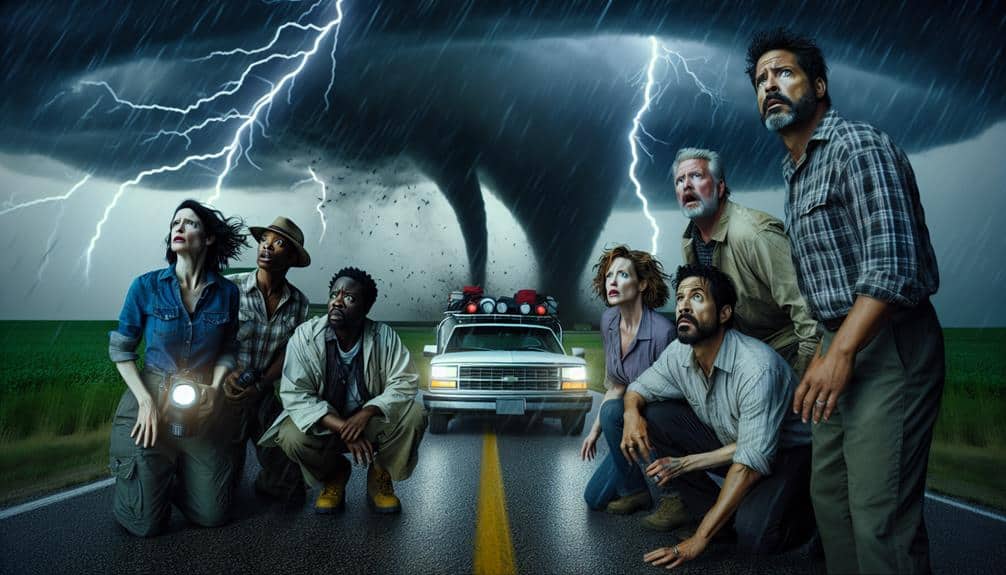
Storm chasing fosters a unique sense of community and camaraderie among those who share a passion for understanding severe weather phenomena. As we navigate through turbulent skies and unpredictable storms, the shared experiences and strong bonds we form are unparalleled. We're not just individuals chasing adrenaline; we're a cohesive unit driven by mutual support and teamwork.
Every storm chase is a story, a set of data points, and a memory that binds us together.
The intensity of our missions strengthens our relationships, creating an unspoken trust and camaraderie.
In high-risk scenarios, knowing we can rely on each other enhances both our safety and our scientific outcomes.
Our community thrives on data analysis and the exchange of technical knowledge. Each member brings a unique skill set, whether it's meteorological expertise, navigation, or advanced photography.
With the freedom to explore and the thrill of the chase, we push the boundaries of weather science together.
This collective effort not only enriches our understanding of severe weather but also solidifies the teamwork and mutual support that make storm chasing a truly collaborative endeavor.
Frequently Asked Questions
How Can Someone Start a Career in Storm Chasing?
To start a career in storm chasing, we need specialized equipment like radar systems and GPS. Finding storms requires analyzing meteorological data and tracking severe weather patterns. Let's embrace the freedom and thrill of this exciting path!
What Are the Most Common Safety Precautions for Storm Chasers?
Did you know 70% of storm chasers use advanced safety equipment and protocols? When we chase storms, risk management and preparation are essential. We follow strict protocols, including vehicle reinforcements and real-time weather data analysis, ensuring our safety.
What Kind of Training Is Required for Storm Chasers?
For storm chasers, training includes basic meteorology to understand weather patterns and emergency response skills for safety. We analyze data, learn technical terminology, and guarantee we're equipped to handle unpredictable situations while maintaining our freedom to explore.
How Do Storm Chasers Fund Their Expeditions?
Where there's a will, there's a way. We utilize sponsorship opportunities and crowdfunding campaigns to manage equipment costs and travel expenses. This financial strategy guarantees our storm chasing endeavors remain sustainable and scientifically productive.
Are There Legal Restrictions on Storm Chasing Activities?
Regarding the current question, there are legal implications and permissions we must consider. Various safety regulations and limitations guarantee our safety and that of the public while chasing storms. Compliance minimizes risks and maximizes our freedom to explore.
